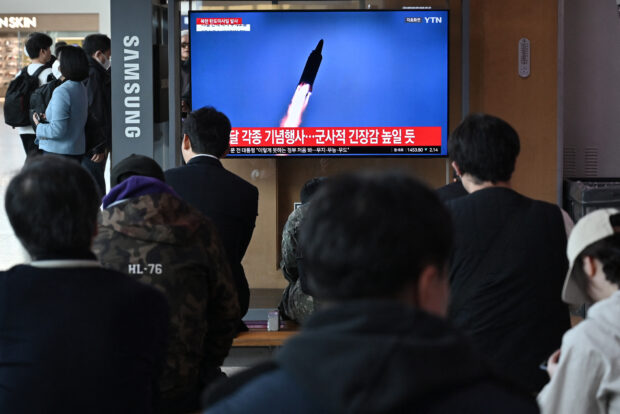

People watch a television screen showing a news broadcast with file footage of a North Korean missile test, at a railway station in Seoul on April 2, 2024. North Korea fired a medium-range ballistic missile on April 2, Seoul’s military said, the latest in a spate of banned weapons tests by Kim Jong Un’s regime this year. (Photo by Jung Yeon-je / AFP)
North Korea’s latest weapons test was of a medium-to-long-range hypersonic missile, state media said Wednesday, adding that leader Kim Jong Un was present for the launch.
“A new medium-to-long range hypersonic missile test launch that carries military strategic value was successfully carried out,” state media agency KCNA said a day after the test.
With the launch, Kim said the North had now “achieved strategic missiles that are of solid-fuel, warhead maneuverable and nuclear-capable.”
Seoul’s military said the missile, launched early Tuesday, flew around 600 kilometers (370 miles) before splashing down in waters between South Korea and Japan. KNCA put the figure around 1,000 kilometers.
Pyongyang’s latest launch, of a Hwasong-16 missile, comes less than two weeks after Kim supervised a solid-fuel engine test for an intermediate-range hypersonic missile.
North Korea has long sought to master more advanced hypersonic and solid fuel technologies, to make its missiles more capable of neutralizing South Korean-US missile defense systems and threaten America’s regional military bases.
Hypersonic missiles are faster and can maneuver mid-flight, making them harder to track and intercept, while solid-fuel missiles do not need to be fueled before launch, making them harder to find and destroy, as well as quicker to use.
The Tuesday launch “appears to be part of Pyongyang’s missile development blueprint, including hypersonic weapons,” said Han Kwon-hee of the Korea Association of Defense Industry Studies.
Later that same day, Seoul’s defense ministry said it conducted a joint aerial exercise with Washington and Tokyo involving a nuclear-capable B-52H bomber and F-15K fighter jets near the Korean peninsula.